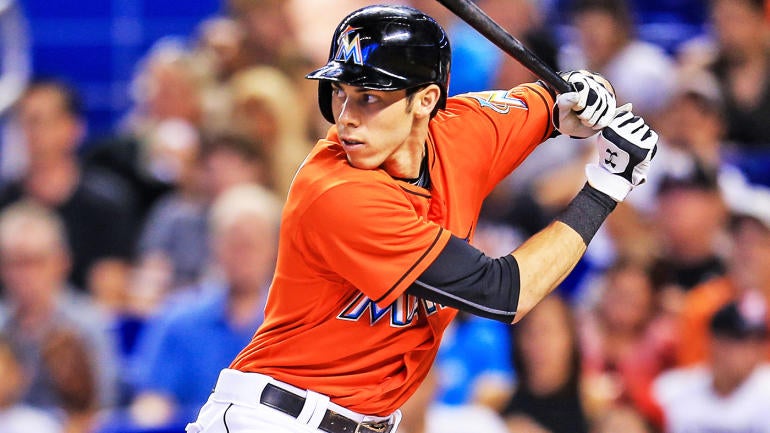
On Wednesday, the Miami Marlins continued their latest overhaul, trading awayMarcell Ozuna the same way they had dealt off Giancarlo Stanton and Dee Gordon. Applying the logic that dictates there's no such thing as a halfway crook, it stands to reason there should be no such thing as a halfway fire sale. No matter how misguided, cynical or cheap the Marlins' acts have seemed, stopping now serves no purpose: It doesn't give the Marlins a much better on-field product or long-term hope, and it certainly doesn't save face or appease the fan base.
The Marlins should -- and reportedly will, to some extent -- go on then, stripping their budget and accumulating as many prospects as possible. Just whom else do the Marlins have to trade? Here's a guide to their remaining assets.
As noted above, the Marlins are shopping around 26-year-old outfielder Christian Yelich. In five big-league seasons, he's yet to post an OPS+ below the 110 mark. He's tapped into his power more the past two seasons, smacking 39 of his 59 career home runs while maintaining his high batting average and on-base percentage. Yelich's sweet swing comes with a sweeter contract. He's under control through at least the 2021 season for less than $45 million. Yelich's contract includes a club option for 2022 that will pay him just $15 million -- or far less than his market value. He should demand a big payout, but bet on some team paying the piper to get an All-Star-caliber outfielder.
Beyond Yelich, the Marlins have a number of young, controllable role players. Catcher J.T. Realmuto has developed into an above-average hitter who won't reach free agency until after 2020. He's historically received poor marks in framing, but it's worth noting his metrics improved in 2017, suggesting he could be a competent two-way backstop heading forward. First baseman Justin Bour (under team control until the winter of 2020) could appeal to any team looking for another bat. He's a more well-rounded hitter than his beer-league aesthetic suggests, and he's actually posted reverse splits for his career. Reliever Kyle Barraclough would also make sense for teams seeking bullpen help.
Second baseman Starlin Castro was just acquired in the Stanton deal, but has already seen his name surface in connection with the New York Mets. He's a solid performer whose contract calls for him to make about $21 million over the next two seasons. From there, his employer will have to decide between a $16 million club option and a $1 million buyout. It shouldn't surprise anyone if Castro never suits up for the Marlins.
Another veteran who does figure to be on the move? Righty Dan Straily, whose league-average or better performances would make him a nifty fit at the back of a contender's rotation. He's under control through the 2020 season.
As for the other veterans, the Marlins would undoubtedly love to ship off third baseman Martin Prado (owed nearly $30 million over the next two seasons), lefty Wei-Yin Chen (more than $50 million over the next three years), and relievers Brad Ziegler and Junichi Tazawa ($16 million combined in 2018). But each has their blemishes when it comes to health and performance that will prevent heavy interest. Edinson Volquez is also due a fair chunk of change ($13 million). Seeing as how he underwent Tommy John surgery late in the season, it's improbable he'll be movable, barring a Bronson Arroyo-like deal where the Marlins attach him with a better asset. In all likelihood, these contracts will buttress the Marlins' otherwise bare bones payroll.
Bottom line, the Marlins have more talent to move if they want to do so in the coming days. We'll see if they keep active -- or, if for whatever reason, they decide enough is enough.
Bagikan Berita Ini















0 Response to "Hot Stove: Buyer's guide to what remains of Marlins fire sale under Jeter, Sherman"
Post a Comment